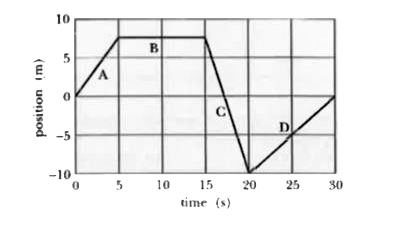Complete Solutions to PRACTICE QUESTIONS ( Linked Comprehension ) of chapter MOTION ALONG A STRAIGHT LINE of Class 12 book with complete answers and questions
| Class 12 | PHYSICS |
| Chapter | MOTION ALONG A STRAIGHT LINE |
| RESNICK AND HALLIDAY | PRACTICE QUESTIONS ( Linked Comprehension ) |
| Number Of Questions | 15 |
| Academic Year | 2023-24 |
A racecar, traveling at constant speed, makes one lap around a circular track of radius r in a time t .
When the car has traveled halfway around the track, what is the magnitude of its displacement from the starting point ?
View SolutionA racecar, traveling at constant speed, makes one lap around a circular track of radius r in a time t .
What is the average speed of the car for one complete lap ?
View SolutionA racecar, traveling at constant speed, makes one lap around a circular track of radius r in a time t .
Determine the magnitude of the average velocity of the car for one complete lap.
View SolutionA racecar, traveling at constant speed, makes one lap around a circular track of radius r in a time t .
Which one of the following statements concerning this car is true ?
View SolutionThe figure shows the speed as a function of time for an object in free fall near the surface of the earth. The object was dropped from rest in a long evacuated cylinder .

Which one of the following statements best explains why the graph goes through the origin ?
View SolutionThe figure shows the speed as a function of time for an object in free fall near the surface of the earth. The object was dropped from rest in a long evacuated cylinder .

What is the numerical value of the slope of the line ?
View SolutionThe figure shows the speed as a function of time for an object in free fall near the surface of the earth. The object was dropped from rest in a long evacuated cylinder .

What is the speed of the object 3.0 seconds after it is dropped ?
View SolutionThe figure shows the speed as a function of time for an object in free fall near the surface of the earth. The object was dropped from rest in a long evacuated cylinder .

If the same object were released in air, the magnitude of its acceleration would begin at the free-fall value, but it would decrease continuously is zero as the object continued to fall. For which one of the choices given does the solid line best represent the speed of the object as a function of time when it is dropped from rest in air ?
Note: The dashed line shows the free-fall under vacuum graph for comparison.
View SolutionA rock, dropped from rest near the surface of an atmosphere-free planet, attains a speed of 20.0 m/s after falling 8.0 m.
What is the magnitude of the acceleration due to gravity on the surface of this planet ?
View SolutionA rock, dropped from rest near the surface of an atmosphere-free planet, attains a speed of 20.0 m/s after falling 8.0 m.
How long did it take the object to fall the 8.0 m mentioned ?
View SolutionA rock, dropped from rest near the surface of an atmosphere-free planet, attains a speed of 20.0 m/s after falling 8.0 m.
How long would it take the object, falling from rest, to fall 16 m on this planet ?
View SolutionA rock, dropped from rest near the surface of an atmosphere-free planet, attains a speed of 20.0 m/s after falling 8.0 m.
Determine the speed of the object after falling from rest through 16 m on this planet .
View SolutionAn object is moving along a straight line in the positive x direction. The graph shows its position from the starting point as a function of time. Various segments of the graph are identified by the letters A, B, C, and D.

Which segment(s) of the graph represent(s) a constant velocity of +1.0 m/s ?
View SolutionAn object is moving along a straight line in the positive x direction. The graph shows its position from the starting point as a function of time. Various segments of the graph are identified by the letters A, B, C, and D.

What was the instantaneous velocity of the object at the end of the eighth second ?
View SolutionAn object is moving along a straight line in the positive x direction. The graph shows its position from the starting point as a function of time. Various segments of the graph are identified by the letters A, B, C, and D.

During which interval(s) did the object move in the negative `x` direction ?
View Solution
PRACTICE QUESTIONS ( Linked Comprehension ) questions and complete solutions for chapter MOTION ALONG A STRAIGHT LINE of RESNICK AND HALLIDAY PHYSICS (HINGLISH) of Class 12
All Exercises from RESNICK AND HALLIDAY Class 12 PHYSICS MOTION ALONG A STRAIGHT LINE
- Checkpoints
- PRACTICE QUESTIONS ( Integer Type )
- PRACTICE QUESTIONS ( Linked Comprehension )
- PRACTICE QUESTIONS ( Matrix-Match)
- PRACTICE QUESTIONS ( More than One Correct Choice Type )
- PRACTICE QUESTIONS ( Single Correct Choice Type)
- PROBLEMS
- SAMPLE PROBLEM 2.01
- SAMPLE PROBLEM 2.02
- SAMPLE PROBLEM 2.03
- SAMPLE PROBLEM 2.04
- SAMPLE PROBLEM 2.05
- SAMPLE PROBLEM 2.06
- SAMPLE PROBLEM 2.07
- SAMPLE PROBLEM 2.08
- SAMPLE PROBLEM 2.09
- SAMPLE PROBLEM 2.10